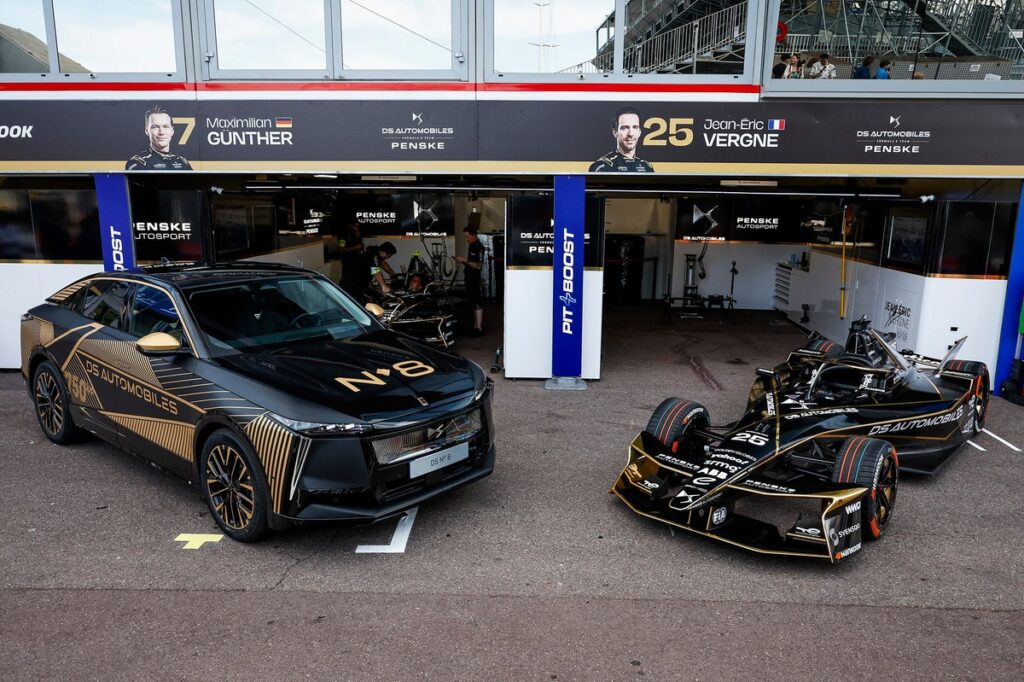Since its creation in 2014, DS Automobiles has embraced the motto of “spirit of avant-garde,” using motorsport as a true innovation laboratory to benefit its production vehicles.
Considered a technological accelerator, motorsport offers an extreme environment to test and refine, in real-world conditions, materials, components, and processes that will ultimately equip – albeit in a modified form – the brand’s future models. The French manufacturer particularly benefits from its commitment to the Formula E world championship, in which it has already secured four titles (two drivers’ and two teams’) in 10 seasons. In this context, several of its hybrid or electric models have already drawn directly from what the brand has learned through competition.
A clear link between track and road
DS Automobiles’ involvement in Formula E goes far beyond a simple marketing platform. While it certainly enhances the brand’s global communications efforts, it also serves as a powerful demonstration of the relevance of its innovations.
DS N°8
Photo by: DS Automobiles
The racing environment is highly demanding, where performance and durability are critical, and where no simulator can fully replicate reality. In the DS Automobiles line up, the latest model to benefit from this synergy is the DS N°8, the brand’s new flagship vehicle, which directly incorporates concepts derived from electric racing. Thanks to technological bridges, whether in hardware or software, this elegantly aerodynamic sedan boasts a record-breaking 750km range on the WLTP cycle.
“By renewing our commitment to Formula E over the past decade, we are capitalising on this experience to evolve our electrified models,” explains Xavier Peugeot, CEO of DS Automobiles. “Our DS N°8 embodies this vision with an exceptional range that would not have been possible without the expertise gained in competition.”
Cutting-edge technologies
One of the keys to this outstanding range doesn’t lie solely in battery capacity or aerodynamic efficiency. A major factor is the refinement of the regenerative braking software. Optimised to capture kinetic energy during deceleration phases, the system efficiently recharges the battery while driving, thus extending the vehicle’s range.

DS Penske, DS E-Tense FE25, DS N°8
Photo by: A. Vincent / DPPI
In racing, capturing and rapidly storing energy to redistribute it just as quickly is essential to maximise performance. In fact, without this energy recovery – which occurs on about 30% of a lap – Formula E cars wouldn’t even reach the finish line. “Our mission in motorsport plays a fundamental role in the development of our production models,” says Eugenio Franzetti, director of DS Performance, DS Automobiles’ motorsport division. “Our sporting and technological goals are aligned, and our 10 years of experience in the series have already led to numerous improvements across our line-up, whether in hybrid, plug-in hybrid, or fully electric vehicles.”
A racing heritage for an electric future
Beyond range and energy recovery, motorsport also allows for the enhancement of vehicle management software, particularly the One-Pedal function. Inspired by Formula E drivers’ need to preserve energy, this feature enables effective and adjustable engine braking simply by lifting off the accelerator pedal. It makes driving smoother and, in some cases, allows the vehicle to come to a stop without touching the brake pedal at all.
While motorsport has long been a source of innovation in the automotive industry, Formula E has rekindled some of the sport’s original technological roots without allowing marketing to overshadow the engineering. DS Automobiles took full advantage by being the first premium manufacturer to commit to the series – and it is now reaping the rewards.
In this article
Didier Laurent
Formula E
DS Penske
Be the first to know and subscribe for real-time news email updates on these topics
Subscribe to news alerts
Read the full article here

